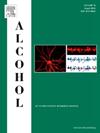The use of baclofen to reduce alcohol-attributable hospitalizations and emergency department admissions
IF 2.9
4区 医学
Q3 PHARMACOLOGY & PHARMACY
引用次数: 0
Abstract
Aims
The potential benefit of baclofen in reducing hospitalizations and emergency department (ED) admissions attributed to alcohol-related diagnoses has not been conclusively established. This study aimed to examine the relationship between baclofen use and the incidence of alcohol-attributable hospitalizations and ED admissions in the general population.
Methods
We conducted a self-controlled case series study (SCCS) using data from the Taiwan National Health Insurance Research Database. 2904 patients who had at least one alcohol-attributable hospitalization or emergency department admission and were prescribed 28 or more days of baclofen unrelated to alcohol were included. Conditional Poisson regression was used to estimate the incidence rate ratio (IRR) and 95% confidence interval (CI) for the risk of alcohol-attributable hospitalizations and ED admissions during exposure to baclofen, as well as the pre- and post-exposure periods, relative to the baseline period. The contribution of concomitant psychotropic medication use was also assessed.
Results
Baclofen was associated with a reduced incidence of alcohol-attributable hospitalizations (IRR = 0.64; 95% CI: 0.53∼0.77) and ED admissions (IRR = 0.56; 95% CI: 0.49∼0.65) in multivariate models. No statistically significant reduction was observed in any admission method in either the pre- or post-exposure period. A dose-dependent response in ED admissions was observed with baclofen, i.e. >60 mg/day associated with a greater decrease in the IRR (0.25, 95% CI: 0.10∼0.62) relative to doses of <30 (0.63, 95% CI: 0.53∼0.75) and 30–60 mg/day (IRR = 0.50, 95% CI: 0.40∼0.63).
Conclusions
These findings suggest a possible beneficial effect of baclofen in reducing the incidence of alcohol-attributable hospitalizations and ED admissions.
使用巴氯芬减少酒精引起的住院和急诊住院。
目的:巴氯芬在减少因酒精相关诊断导致的住院和急诊(ED)入院方面的潜在益处尚未最终确定。本研究旨在探讨巴氯芬的使用与普通人群中因酒精引起的住院和急诊科入院发生率之间的关系。使用条件泊松回归来估计巴氯芬暴露期间酒精导致的住院和急诊风险的发生率比(IRR)和95%置信区间(CI),以及暴露前后相对于基线期的风险。同时还评估了伴随精神药物使用的贡献。结果:巴氯芬与酒精引起的住院发生率降低相关(IRR=0.64;95% CI: 0.53 ~ 0.77)和ED入院(IRR=0.56;在多变量模型中95% CI: 0.49 ~ 0.65)。无论是暴露前还是暴露后,任何入院方法均未观察到统计学上显著的减少。在ED入院患者中观察到巴氯芬的剂量依赖性反应,即与< 30 (0.63,95% CI: 0.53 ~ 0.75)和30 ~ 60 mg/天(IRR=0.50, 95% CI: 0.40 ~ 0.63)的剂量相比,bbb60 mg/天与IRR (0.25, 95% CI: 0.10 ~ 0.62)的降低相关(0.25,95% CI: 0.10 ~ 0.62)。结论:这些发现表明巴氯芬在减少酒精引起的住院和急诊科入院发生率方面可能具有有益作用。
本文章由计算机程序翻译,如有差异,请以英文原文为准。
求助全文
约1分钟内获得全文
求助全文
来源期刊

Alcohol
医学-毒理学
CiteScore
4.60
自引率
4.30%
发文量
74
审稿时长
15.6 weeks
期刊介绍:
Alcohol is an international, peer-reviewed journal that is devoted to publishing multi-disciplinary biomedical research on all aspects of the actions or effects of alcohol on the nervous system or on other organ systems. Emphasis is given to studies into the causes and consequences of alcohol abuse and alcoholism, and biomedical aspects of diagnosis, etiology, treatment or prevention of alcohol-related health effects.
Intended for both research scientists and practicing clinicians, the journal publishes original research on the neurobiological, neurobehavioral, and pathophysiological processes associated with alcohol drinking, alcohol abuse, alcohol-seeking behavior, tolerance, dependence, withdrawal, protracted abstinence, and relapse. In addition, the journal reports studies on the effects alcohol on brain mechanisms of neuroplasticity over the life span, biological factors associated with adolescent alcohol abuse, pharmacotherapeutic strategies in the treatment of alcoholism, biological and biochemical markers of alcohol abuse and alcoholism, pathological effects of uncontrolled drinking, biomedical and molecular factors in the effects on liver, immune system, and other organ systems, and biomedical aspects of fetal alcohol spectrum disorder including mechanisms of damage, diagnosis and early detection, treatment, and prevention. Articles are published from all levels of biomedical inquiry, including the following: molecular and cellular studies of alcohol''s actions in vitro and in vivo; animal model studies of genetic, pharmacological, behavioral, developmental or pathophysiological aspects of alcohol; human studies of genetic, behavioral, cognitive, neuroimaging, or pathological aspects of alcohol drinking; clinical studies of diagnosis (including dual diagnosis), treatment, prevention, and epidemiology. The journal will publish 9 issues per year; the accepted abbreviation for Alcohol for bibliographic citation is Alcohol.
 求助内容:
求助内容: 应助结果提醒方式:
应助结果提醒方式:


